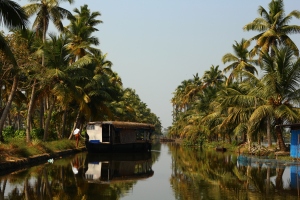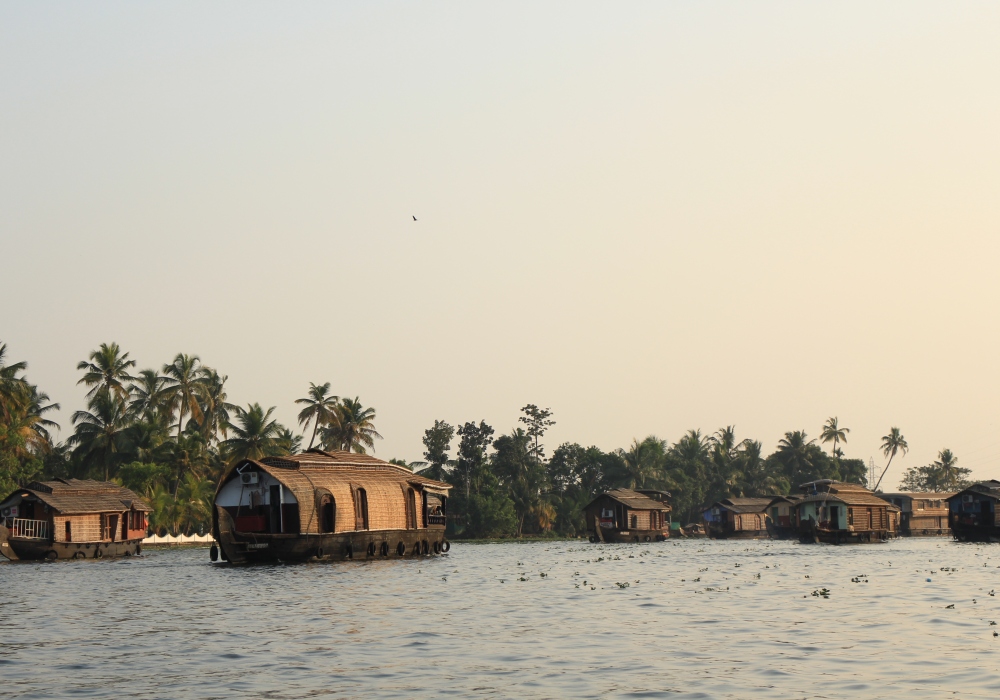
Following the ridge through morning fog

View form the top

Atop Mt tadiandamol
Back inland we headed via bus for a few hours to the Coorg district of Karnataka state for some more hill station time. Our first stop was the Honey Valley Resort, situated amid foothills of the Western Ghats mountain range. A former apiary turned guest house, Honey Valley is well known among travellers for being one of the best spots to trek the Ghats. The most famous trek to Mt. tadiandamol (highest peak in Coorg and Southern India) sets off from the guest house grounds, along with many other hikes of vary length and difficulty. Given we had one full day planned, we thought it best to take on tadiandamol in the morning. The owner dismissed my request for a guide, and gave us a trail map and book. Written by westerners visiting the valley many years ago, the books were helpful, but the directions on accessing the trail were lacking detail and maps were sparsely drawn. We received additional advice from other hikers who ventured without a guide. Both groups we had spoken to got lost and were not sure of the path at more than one point. At any rate, we were going to give it a shot on our own.
We headed out before breakfast with a packed lunch consisting of bread, jelly, carrots, boiled eggs, and cookies, our guide book and lots of water. The first step was to find the trailhead at the junction. This in itself proved difficult and eventually we asked for guidance from the staff after wandering around. Shortly after, the trail came to a fork as the climb up the first ridge began. We chose the narrow route towards the right over the wider route heading straight. It was a mere guess. After passing a herd of cattle, we found ourselves on a gradually diminishing path along a grassy steep hillside. The cattle tracks wandering back and forth across the hill eventually led us to a point where a path was no longer discernable. Our book and advice had been to follow the ridge until the mountain came into view. The grass turned into bush just over head height, and we were plowing through, looking for a waterfall as a landmark. After struggling over an hour through the near impassable terrain, arms scrapped with thorns, we were at the point of turning back. We thought it was best to make our way higher to the top of the ridge to get a better grasp on our position. The ridge top finally welcomed us with a well worn footpath, definitely created by humans. Then we looked further beyond the ridge and spotted tadiandamol in the distance. Standing between us and the summit was a large sloping valley covered in forest, and another long ridge leading the the base. Renewed by our confirmation that at least we were headed in the right direction, we continued onward, following the ridgetop path until abruptly the ridge ended in a steep cliff. Again we were searching for clues of the trail, but were only guessing. After descending the hill towards the forest, about halfway down the path dissipated. We crossed a small streambed upon entering the forest, but continued towards the bush on the far side to get a better view. The problem was we could not determine the best path (if there even was one) to the next definite ridge. From that point on, it appeared, the trail was easy to follow all the way ot the summit. The book at this point was no use. We spent another hour manuvering on the steep hillside just above the forest, but each corner we rounded it seemed there was no answers, and the terrain simply responded with thicker vegetation and bush to wade through. After over four hours of mostly trailblazing, we took a lunch break on a small hill above the forest. We had heard the trek was doable in seven hours round trip although we were well behind by this point, less than halfway to the peak. Fatigued and scarred, we decided to turn back as there wasn’t enough time left in the day even if we did manage to find the right path up the ridge. Once through the thick forest, we took a shorter route back to the first ridge, found the footpath and followed it back. Although defeated, we made some good discoveries on our return: the waterfall mentioned as a landmark was in an entirely different location than we thought, and the wide path at the fork was the far easier route to the ridgetop. Not to be ones to give up, we decided to try the peak again the next morning, and to insist on a guide. We also learned that a few other guests were interested. That night at dinner we shared our misfortune with the fellow trekkers, hoping that the next day would be different.
Our group of five and our guide set off after breakfast. We had preferred to start earlier in the day, but we were at the will of the guide. In no time we traced the same route to the fork, and headed straight up the wide path. In ten minutes we made it to the ridgetop, and followed the rolling trail. The low fog in the valley was being swept over the ridge as we walked across (something that looked stunning in reality but mediocre in pictures). In no time we reached the same spot at the end of the ridge, and our guide led us down an easy path (that we likely walked past, as there was no landmark at this point) towards the stream. The route then took a turn away from the thick forest and through some grasses. We came out into a clearing and found ourselves at the base of the second ridge, leading to the peak. From there, our guide led us on a contoured trail along the base of the ridge, cutting out the time needed to acende the entire ridge. Once reaching the base of the mountain, we realized that what looked like a continuous ridge actually ended in another saddle, so the path along the lower elevation was faster. The path up to tadiandamol was rock and root filled but not too difficult. The large grassy summit greeted us with 360 degree views of untouched wilderness. We managed to hike 8 km in just over three hours. We spent an hour eating and taking in the views before descending. We would have chosen to hike all the way back on foot but we had a bus to catch to our next stop, Madikeri, about 35 km by bus, so we were picked up by Jeep near the mountain base.
Arriving just before sundown in the bustling city of Madikeri, we walked over to our accommodation, Hotel Hill View, and caught a glimpse of the last colors of sunset from our room. We chose to stay in the area since it was enroute to our next major stop in Mysore. Also located nearby was a Tibetan settlement that we wanted to explore. To reward ourselves for the successful completion of Tadiandamol after two attempts, we dined at an upscale restaurant on some delicious curry and parathas. After a solid nights sleep, we ventured out into the urban bustle of Madikeri in search of the renowned Coorg coffee. It was a Sunday, which meant many of the hotels and shops were closed, but eventually we sampled the coffee at the Raintree Cafe. It was certainly spiced and flavorful. Back to our journey, we made our way to the government bus station (aka KSRTC- Karnataka State Road Transport Corporation). By now we had taken enough buses to know the drill: bus drivers and conductors yelling their destinations (as if their life depends on it), no schedules, and no limit on the number of passengers crammed on board. We walked without stopping into the station and onto a bus, after a quick confirmation from the conductor, then the bus lurched forward. In the few minutes it took the bus to make its way onto the main street, the conductor continued his relentless shouts of “MysuMysuMysuMysu” as stragglers climbed on. Even on the buses, there are dedicated seats for “Ladies”. Fares on the government buses are approximately 1 Rs per km.
12.337494
75.806908














































